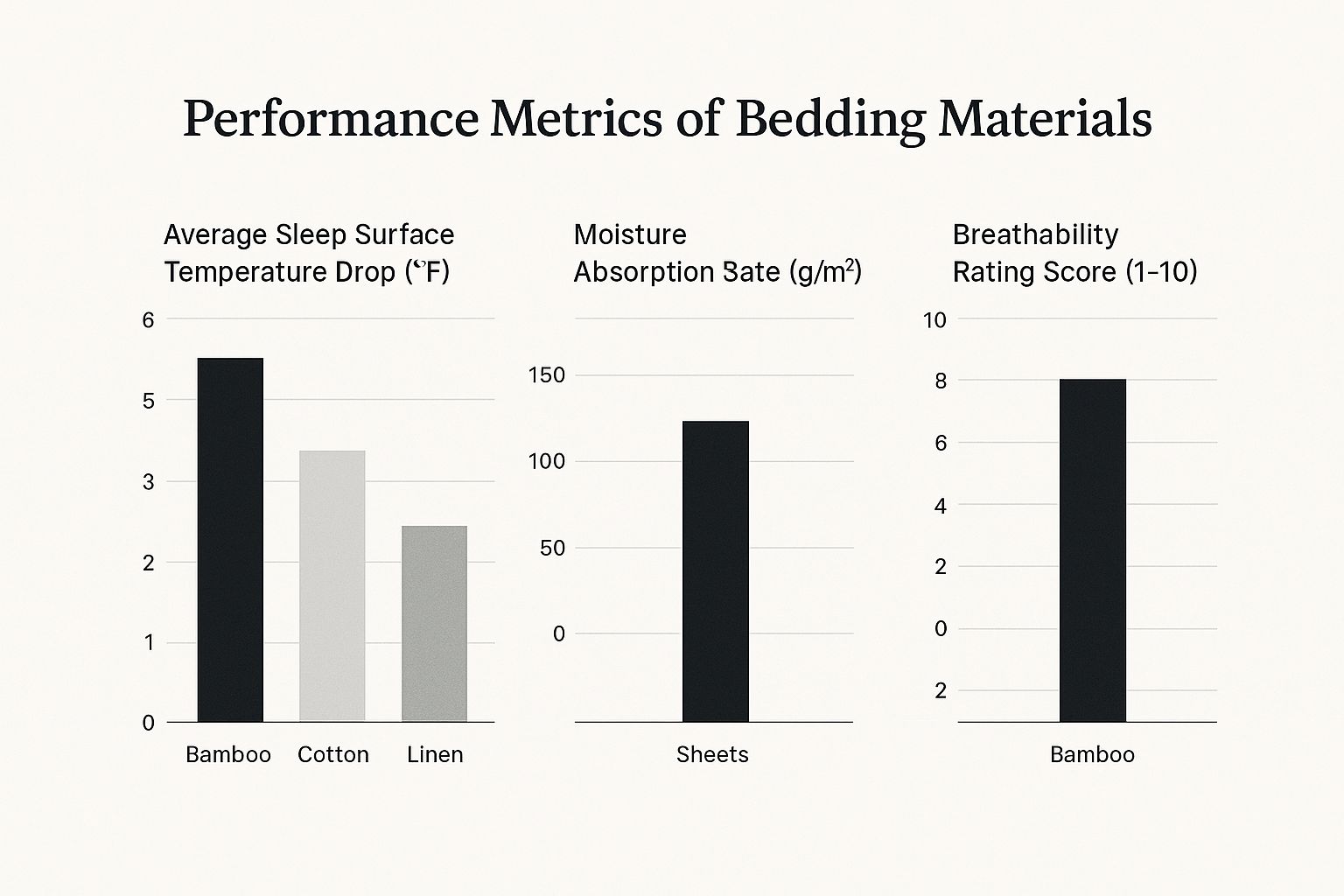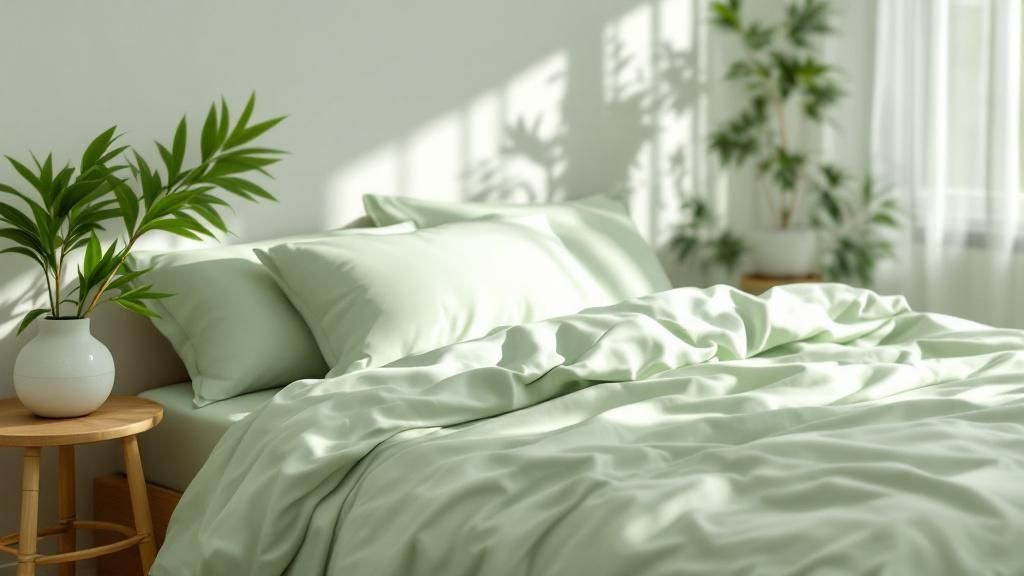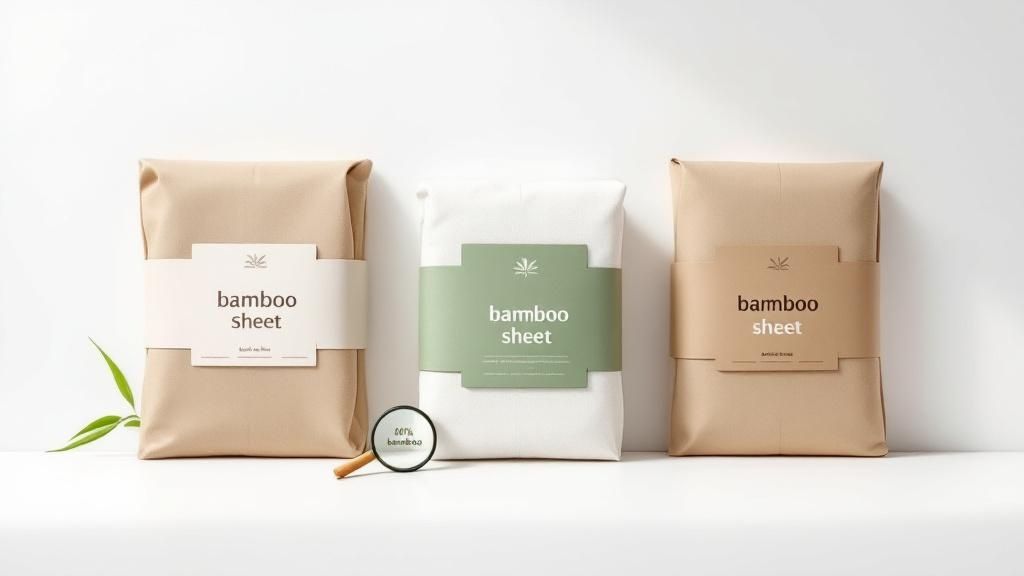If you're a hot sleeper, you already know the struggle. Tossing, turning, and waking up drenched is no way to get a good night's rest. For a long time, we were told cotton was the answer, but anyone who sleeps hot knows it can quickly turn into a damp, clammy mess.
This is exactly why bamboo sheets have become a proven solution for cooler nights. They don't just feel cool; they actively work to regulate your body temperature, offering a real path to uninterrupted sleep.
Why Bamboo Sheets Are a Game-Changer for Hot Sleepers
Whether it's the summer humidity, hormonal shifts, or just your natural body heat, waking up in a sweat is incredibly frustrating. The problem with many traditional fabrics is that they trap heat and moisture right next to your skin.
Bamboo, on the other hand, is different by design. Its fibers have a unique, porous structure that creates microscopic channels, allowing heat and humidity to escape away from your body. The result? Bedding that feels breathable and stays that way all night long. No more stuffy, trapped feeling.
Superior Moisture and Temperature Control
Beyond simple airflow, bamboo is a moisture-wicking champion. It actively pulls sweat away from your skin and disperses it across the fabric, where it can evaporate quickly. This is what keeps you feeling dry and comfortable, preventing that clammy sensation that so often ruins sleep.
It's a tangible performance benefit that directly addresses the core problem for hot sleepers. Think of it as built-in climate control for your bed.

The numbers back this up. Did you know bamboo is three times more absorbent than cotton? This incredible absorbency is a key reason so many people are making the switch.
It’s no surprise that the global bamboo textile market, valued at around USD 2.7 billion in 2023, is projected to nearly double by 2032. People are seeking out effective, comfortable, and eco-friendly solutions for better sleep, and bamboo delivers.
Bamboo vs Traditional Sheets for Hot Sleepers
Here's a quick comparison of how bamboo stacks up against common bedding materials when it comes to keeping you cool.
| Feature | Bamboo Sheets | Cotton Sheets | Microfiber Sheets |
|---|---|---|---|
| Breathability | Excellent; porous fibers promote airflow. | Good, but can become less breathable when damp. | Poor; synthetic fibers tend to trap heat. |
| Moisture-Wicking | Superior; pulls sweat away from the skin. | Absorbs moisture but dries slowly. | Repels moisture but doesn't absorb it well. |
| Feel | Silky, smooth, and cool to the touch. | Can feel crisp or soft depending on the weave. | Can feel soft but often synthetic and slippery. |
| Temperature Control | Actively helps regulate body temperature. | Can hold heat, especially when wet. | Notoriously traps heat, bad for hot sleepers. |
As you can see, bamboo consistently comes out on top for the features that matter most for a cool and comfortable night's sleep.
For those seeking relief, the choice is clear. Bamboo sheets for hot sleepers offer a direct path to a more restorative night by tackling overheating at its source—the fabric itself.
Ultimately, choosing the right bedding is personal, but for anyone tired of battling night sweats, understanding the real-world benefits of bamboo is the first step. To learn more, check out our guide on why bamboo sheets are an eco-friendly choice for hot sleepers.
The Science Behind a Cooler Night's Sleep
Ever wonder what actually makes bamboo sheets for hot sleepers feel so cool and refreshing? It’s not just a clever marketing gimmick; the answer is woven right into the fabric's structure. If you were to look at bamboo viscose fibers under a microscope, you'd see they're full of tiny, porous gaps.

These microscopic holes are the real heroes here. They create natural channels that let air flow freely through the fabric. Unlike traditional cotton or synthetic materials that can trap body heat and create a stuffy, sauna-like effect, bamboo allows that warmth to escape. This built-in temperature management is what we call thermoregulation.
Think of it as your bed having its own natural ventilation system. As your body heats up during the night, the fabric gets to work, pulling that excess heat away from you. This helps you stay in that sweet spot for deep, restorative sleep.
More Than Just Breathable
The benefits don't stop at just letting air through. Bamboo fibers are also incredible at managing moisture. They actively pull sweat away from your skin—a process known as moisture-wicking—and disperse it across the surface of the sheet. From there, it evaporates quickly, keeping you dry and comfortable instead of sticky and damp.
It's this impressive performance that has caught on with consumers. The global bamboo fiber market is actually expected to jump from USD 4.06 billion to over USD 15.5 billion by 2033. People are catching on to bamboo's unique combination of comfort and sustainability. You can read more about the rise of bamboo textiles and see the data for yourself.
On top of all that, bamboo has a natural advantage against allergens. The plant itself contains a bio-agent that helps it resist pests, and some of that quality carries over to the fabric, making it naturally hypoallergenic.
For anyone with sensitive skin or allergies, this is a game-changer. Bamboo sheets are far less likely to harbor dust mites and other irritants, creating a cleaner, healthier place to rest your head.
It’s this powerful trio of thermoregulation, moisture-wicking, and hypoallergenic properties that makes bamboo a smart, science-backed choice for anyone who sleeps hot. It’s not just about how the sheets feel at first touch—it's about how they perform all night long.
How to Choose the Right Bamboo Sheets

Diving into the world of bamboo bedding can feel a little overwhelming at first. But once you know what to look for, finding the perfect bamboo sheets for hot sleepers is actually pretty straightforward. The trick is to look past the marketing jargon and focus on what really matters for a cool, comfortable night's sleep.
First things first, it's important to know that not all bamboo fabric is the same. The vast majority of bamboo sheets are made from bamboo viscose (you might also see it called rayon). This process transforms bamboo pulp into that incredibly soft, silky fabric everyone raves about. While they all start from bamboo, the end quality can vary quite a bit.
What to Know About Weave and Thread Count
When you're shopping for bamboo sheets, the weave of the fabric is often a much better indicator of quality than the thread count. This is a big switch from how we're taught to buy cotton sheets. With cotton, a higher thread count can sometimes lead to a denser, less breathable fabric. For bamboo, the cooling magic is all in the fiber's natural structure and how it’s woven.
- Sateen Weave: This is what you’ll find most often, and for good reason. A sateen weave creates that signature silky-soft feel with a beautiful, subtle sheen. It’s this finish that really enhances the cool-to-the-touch sensation that hot sleepers crave.
- Twill Weave: A twill weave creates a fabric that’s a bit more textured and durable. It’s still wonderfully soft and breathable, but it feels less like silk and a little more like a high-end traditional bedsheet.
While you might see brands boasting about high thread counts, for bamboo, the sweet spot is typically in the 250-400 thread count range. That’s all you need for peak softness and breathability.
Forget everything you've learned about cotton thread counts. When it comes to bamboo, the weave is king. A quality sateen weave is going to give you a much cooler sleep than a super-dense, high-thread-count sheet that can’t breathe.
Check for Quality Certifications
An easy way to cut through the noise and verify a product's quality is to look for official certifications. One of the most important ones to have on your radar is the OEKO-TEX Standard 100 certification.
This label is your guarantee that every single part of the product—from the fabric itself down to the thread and buttons—has been rigorously tested and found to be free of harmful substances. For anyone with sensitive skin, this is non-negotiable. It means you can sleep soundly knowing your bedding is clean, safe, and won't cause irritation.
Making sure your sheets are certified is a simple step that ensures you're bringing a high-quality, safe product into your home. If you want to dive deeper into how the materials stack up, check out our guide comparing bamboo vs. cotton sheets.
How to Keep Your Bamboo Sheets Feeling Brand New
You’ve brought home that incredible, silky-soft feeling, and the last thing you want is to lose it in the wash. Keeping your bamboo sheets in top condition is actually pretty simple, but it does require a slightly different approach than you might be used to with regular cotton. The secret lies in treating the delicate bamboo viscose fibers with a little extra care.
High heat is the biggest threat to your sheets. It’s the fastest way to break down those fine fibers, which leads to annoying pilling and can even cause them to shrink. Harsh detergents and fabric softeners are just as bad—they create a film that clogs the fabric, robbing it of its famous breathability and moisture-wicking magic.
The Right Way to Wash and Dry
To keep that signature softness intact, always stick to a gentle cycle with cold water. This protects the natural structure of the fibers that work so hard to keep you cool at night. It's also a good idea to use a mild, pH-neutral detergent.
When it's time to dry, you've got two great choices:
- Line drying is the absolute best option. It’s gentle on the fibers and leaves your sheets smelling wonderfully fresh.
- If you need to use a machine, tumble dry on the lowest heat setting. Just be sure to pull them out as soon as they're done to keep wrinkles from setting in.
A quick pro-tip: Skip the fabric softener and dryer sheets entirely. They leave a waxy residue that blocks the fabric's pores, which is exactly what you don't want when you're relying on your sheets for their cooling power.
A Few More Tricks for Long-Lasting Softness
Beyond the laundry room, a couple of simple habits can make a big difference. When you’re not using them, store your sheets in a cool, dry spot away from direct sunlight to prevent any yellowing. If you get a stubborn stain, just pre-treat it with a gentle stain remover before tossing it in the wash.
By sidestepping common mistakes like cranking up the heat or using aggressive chemicals, you'll make sure your bamboo sheets for hot sleepers keep delivering that cool, luxurious comfort night after night. For a complete breakdown, check out our full guide on how to care for your bamboo sheets.
The Eco-Friendly Side of Bamboo Bedding
For a lot of people, the appeal of bamboo bedding isn't just about its amazing cooling properties. Choosing bamboo is often a deliberate step toward a more sustainable lifestyle, and it all starts with the plant itself.
Bamboo is one of the most remarkable resources on the planet, famous for being one of the fastest-growing plants in the world.
Think about conventional cotton for a moment—it’s a crop that demands huge amounts of water and pesticides to grow. Bamboo, on the other hand, shoots up with very little fuss. It needs minimal water and thrives without chemical fertilizers or pesticides, making it a naturally hardy and eco-friendly choice. This regenerative growth helps keep the soil healthy and drastically reduces the environmental footprint left by traditional farming.
From Plant to Fabric
Of course, turning that tough plant into silky-soft bamboo sheets for hot sleepers involves a manufacturing process. The methods used to do this can vary quite a bit, so it's worth understanding the differences if you want to make a choice that truly aligns with your values.
The lyocell process, for example, is a real standout when it comes to being green. It uses a closed-loop system, which means over 99% of the water and non-toxic solvents are captured and recycled again and again. This approach dramatically cuts down on waste and environmental impact, marking a huge leap forward for sustainable textile production.
When you choose bamboo bedding made through responsible processes, you are supporting a system that values both your comfort and the planet's health. It connects your purchase to a larger movement of mindful consumerism.
This shift towards greener alternatives is clearly showing up in the market. The global market for bamboo products was valued at around USD 75.5 billion in 2024 and is expected to more than double by 2031, thanks to growing environmental awareness. You can explore the full research about the growth of the bamboo products market.
Ultimately, by choosing thoughtfully produced bamboo, you're doing more than just getting a better night's sleep—you're investing in a healthier planet.
Still Have Questions About Bamboo Sheets?

It's completely normal to have a few questions before you commit to a new set of sheets, especially when you've dealt with overheating for so long. Let's walk through some of the most common things people ask, so you can feel totally confident you're making the right call.
A big one I hear all the time is about durability. Because bamboo fabric feels so incredibly soft and luxe, it’s easy to assume it might be delicate. But here's the good news: with proper care, high-quality bamboo sheets are surprisingly tough. They can last for years without pilling or losing that signature silky feel.
Another popular question is how bamboo sheets for hot sleepers really stack up against other "cooling" options. Think linen or those high-tech synthetic fabrics. While linen is definitely breathable, it just doesn't have that smooth, gentle glide of bamboo. And those synthetics? They might feel cool to the touch at first, but they often end up trapping moisture and feeling clammy.
Do They Need Special Care?
This is a valid concern, but the reality is much simpler than you might think. Calling them "high maintenance" is a bit of a stretch.
You don't need a complicated routine, just a gentle one. The key is to protect the delicate natural fibers.
- Wash on a cool, gentle cycle.
- Tumble dry on low heat (or even better, line dry if you can).
- Skip the harsh stuff like bleach and fabric softeners, as they can break down the fibers.
That’s really it. Following these simple steps will keep your sheets feeling amazing for the long haul.
Are They Only Good for Summer?
What about when the temperature drops? It's a common misconception that cooling sheets will leave you shivering in the winter.
The magic of bamboo is that it's thermoregulating. This means the fabric is smart—it adapts to your body temperature. It helps release heat when you're warm, but it also provides a light, cozy layer of insulation when it's chilly. This makes it a fantastic choice for year-round comfort, not just for hot summer nights.
The bottom line is that bamboo offers a unique combination of exceptional softness, superior moisture-wicking, and proven breathability that other materials struggle to match. It’s a complete package for hot sleepers.
Ready for consistently cool and comfortable nights? Explore the 100% organic bamboo bedding collection from Bamtek and feel the difference for yourself. Shop now at bamtekhome.com.










